Sewer system for a country house. Sewer installation in a country house - expert advice
Unity with nature and life in your own cozy home is the dream of the average inhabitant of a megacity. However, the charm of village idleness noticeably fade, it is only necessary to imagine "convenience" on the street or the difficulty of washing dishes. Completely autonomous sewerage a country house saves a lot of problems, so the dwellers of the villa or luxurious mansion can live in the bosom of nature, continuing to enjoy all the usual benefits of civilization.
Individual systems of out-of-town sewerage
If the dacha is impossible the nearest settlement, it should be established individual system for a particular house.
Cesspit or well of concrete rings
The simplest method, but simplicity is the only advantage of this type of country sewage. The pit must be arranged in such a way that the utility vehicles approach the well for cleaning without problems. But these services still need to be regularly invited for work, which is not easy and expensive in itself. It will be necessary to get used to unpleasant smells and contamination of the site, and the amount of water used will need to be strictly limited.
Storage tanks
These types of sewage are sealed containers for waste with a short period between cleanings. The tanks do not need to be immersed in the land in the country, they are completely resistant to temperature changes and mechanical damage. One thing is bad - their volume is always short.
The natural treatment of sewage with a mechanical septic tank
Such arrangement of the sewage system is suitable for sites with deep-lying underground waters, and there are few such places in the Moscow suburbs. Mechanical suburban sewage is inexpensive, but requires constant supervision and periodic preventive work.
Biological stations for wastewater treatment provide a stable result, do not pollute the soil on the site and do not need frequent inspections. Bio-cleaning systems are the most expensive, and the cost of their operation also bites.
Septic for the house and for the dacha - KLEEN
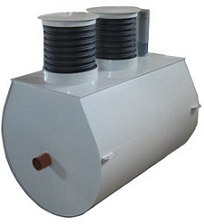
The most profitable solution to problems with the sewage system of a country house is an inexpensive septic tank MAPLE. Waste entering the purification system passes through several stages of treatment, including biofiltration. As a result, the ecological purity of soil, water and air on the site is guaranteed.
Overview of types of models of septic tanks of the KLEEN series
A series of bio septic tanks was created to clean and clarify wastewater in a suburban area, to organize comfortable modern conditions and in a small house in the country, and a large cottage.
Septic CLUE 5 This model is installed in a dry sandy ground with a low level groundwater. The septic tank is capable of cleaning up to 450 liters of sewage per day. Connect the pipes from the sink, washing machine, shower, bath, toilet, dishwasher, installed in the house in the country, where three or five people live permanently, and enjoy the benefits of civilization.
Model CLEAN 5N The same functions of canalization of a country house are carried out with the arrangement of the system in clayey and loamy soils with a high level of groundwater. The weight of the bio-installation is only 57 kilograms, the length is 2 meters, and the height and width are just over a meter.
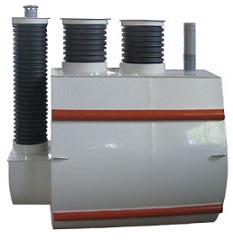
Model CLUE 7 These types of system are designed for cleaning 750 liters of drains per day, that is, it is quite possible to cope with the maintenance of a house where 6-7 people live. Install the model in a dry ground or sand with a low level of groundwater.
KLEEN 7n system A similar model for the arrangement of houses for 5-7 people is installed in clay soils with a high level groundwater. The system weighs 76 kg, height and length - one and a half meters, and width - 1.3 m.
Suburban sewerage, created specifically for the Moscow region
Septic tanks KLEN are ideal for areas with high groundwater, because 70% of suburban land near Moscow have such a characteristic. Most efficiently, KLEN works on loamy, peaty and sandy soils, characteristic of the sites in the Moscow suburbs. The contents of the septic tank should be pumped out only once every two to three years. Waste can be used as a filler for the compost pit. It turns out a closed and non-waste cycle. A simple design and reliable thought-out technology guarantees 40-50 years of impeccable septic service of the CLEN series. detailed instructions will help to install the complete system without your own efforts. The tightness and strength of the system design preserves the biological purity of the environment. The sheet polypropylene housing is resistant to groundwater, cold and heat. Septic CLEN works autonomously. You can live in the house constantly or visit it only in season, the biosystem will work flawlessly, without requiring conservation and constant supervision.
Advantages of the septic tank from the manufacturer
- Advantageous price, excluding "winding" the cost.
- Possibility to choose the best option series KLEHN 5 or 7 for a family of 3-5 or 5-7 people.
- Presence of the certificate of conformity and conclusion of SES for all modifications of septic models.
- Delivery in Moscow and the Moscow region.
- Free departure of the engineer of the company to the installation site for drawing up the plan of installation and the estimate of the forthcoming works.
- Fast, within a day installation of the system of country sewage.
- Payment after the end of installation works.
Guarantees for all buyers of septic tanks KLEN
Sewerage in the house during the first year is served completely free of charge. Buyers can contact the company with any questions about the septic's work. Two weeks after the installation of the system is considered a probationary period. If, for some reason, the cleaning system does not suit the buyer, the company takes all kinds of septic tanks back, because the wishes and requirements of the buyer are most important.
Getting rid of domestic sewage is the main problem that all owners of country houses face. When building a cottage, you should carefully consider the system of sewage facilities, weigh all the pros and cons of this or that equipment. After all, from the right choice in many respects will depend on a comfortable and unnecessary restless residence in the house.
Central sewerage system
The ideal option is centralized system sewage system, which is not only convenient to use, but also very effective. But far from all suburban settlements are equipped with such a system. And where such communication facilities are provided, it is not always possible to connect to their use. The distance, the cost of laying pipes, and sometimes the paid permission to the sidebar often force the owner of a country house to abandon such a seemingly profitable prospect.
Then the question arises: Which autonomous sewer system for a country house to give preference? There are several options, let's look at the proposals now available.
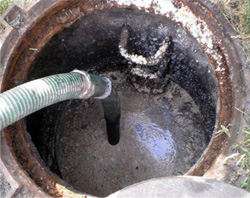 The most primitive, but also the least expensive at the moment is the usual cesspool. A sealed container is placed in a section into which waste water flows from the house and outbuildings. One already fact of periodic cleaning of the cesspool with the help of a sewage machine makes the use of such a sewage system burdensome, expensive and dependent on utilities. For a house with permanent water supply, this option is not suitable also because it is always necessary to economically use water and often check if the container is full. Besides, in cesspool rain or ground water rarely falls. In this case, it is necessary to order special equipment quite often. A lot of trouble is connected with the placement of the cesspool: there must be an entrance to it (for a sewage machine). Do not place a waste water tank near wells, wells, do not recommend in a radius of 30 m from it to grow fruit and garden crops.
The most primitive, but also the least expensive at the moment is the usual cesspool. A sealed container is placed in a section into which waste water flows from the house and outbuildings. One already fact of periodic cleaning of the cesspool with the help of a sewage machine makes the use of such a sewage system burdensome, expensive and dependent on utilities. For a house with permanent water supply, this option is not suitable also because it is always necessary to economically use water and often check if the container is full. Besides, in cesspool rain or ground water rarely falls. In this case, it is necessary to order special equipment quite often. A lot of trouble is connected with the placement of the cesspool: there must be an entrance to it (for a sewage machine). Do not place a waste water tank near wells, wells, do not recommend in a radius of 30 m from it to grow fruit and garden crops.
A more rational option is the use of a septic tank. This simple construction allows mechanical cleaning domestic sewage. Naturally, in such a case, an insignificant part of the waste is filtered out, and the wastewater necessarily requires additional purification, using sand-gravel filters or special filtering wells. The erection of such communications requires both monetary and time costs, but the quality and the result of such sewage leaves much to be desired.
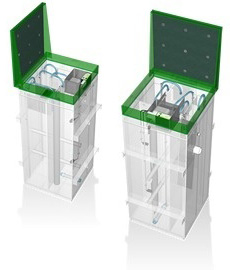 An innovative system in this area can be considered aeration stations that carry out a deep biological treatment of wastewater. Thanks to modern equipment, we now have the opportunity to use a convenient, reliable and profitable system that relieves us of the hassle associated with the disposal of domestic waste water and the purification of domestic water.
An innovative system in this area can be considered aeration stations that carry out a deep biological treatment of wastewater. Thanks to modern equipment, we now have the opportunity to use a convenient, reliable and profitable system that relieves us of the hassle associated with the disposal of domestic waste water and the purification of domestic water.
One of such modern and innovative sewerage facilities is the septic TOPAS , patented by engineer from Czech Republic Jan Topol. His invention is based on the natural process of fermenting organic matter. Inside the station air is supplied, and favorable conditions are created for the vital activity of microorganisms. The fermentation process accelerates, the bacteria multiply and process organic substances. As a result of such intensive activity of microorganisms, activated sludge , which decomposes nitrates, ammonia, eliminates pathogenic bacteria. Additionally, it purifies wastewater by natural filtration.
Sewerage for a country house TOPAS It is very convenient to operate, because it only requires periodic pumping of activated sludge . For this purpose a special pump is designed, that is, there is no need for a sewage machine. Moreover, a muddy sediment is formed as a result of natural processes, so it can be used as a fertilizer for ornamental plants.
Several models of this station allow you to choose the option that will satisfy the needs of your country house. For example, the smallest system TOPAS 5 suitable for a small family of 3-4 people. Sewer for a country house TOPAS 5 slightly more than 2 sq.m. For installation, it is usually not necessary to dig a large pit. The tightness of the container removes unpleasant odors, and the strength of the material and resistance to corrosion - increases the service life. In addition, the system has an aesthetic appearance, because you can see only the green cover of the station, barely visible among the lawn.
Of course, the septic tank TOPAS is more expensive than some other sewage options for a country house, but 50 years of serviceable work (namely, such a period of its operation), without extra costs for its maintenance, costs a one-time investment of money! Agree, the sewerage of a country house is a delicate matter, but once you make the right choice, you can not raise this issue for 50 years.
In a private house or at the dacha they build an autonomous sewage system. It should be simple, efficient, reliable, easy to install and operate. Ideally, the system is planned even at the design stage of the building, but sometimes there is a need to replace old communications. This creates additional difficulties, and they need to be taken into account. What should be the right canalization of a country house? Consider the popular schemes and options for the arrangement.
"Facilities in the yard" can satisfy only if it comes to a suburban area without a water pipe, where the owners appear occasionally and briefly. Works on the improvement of an apartment house primarily involve the installation of water supply and sewerage. They are designed simultaneously. If the water is already connected, the sewage system is "adjusted" to the existing network.
When choosing a scheme for sewerage in a residential house, there should be no mistakes. An improperly assembled network will not work, or if it is exploited, there will be problems
Project local sewage systems for a country house should be as simple as possible in order to minimize the number of errors that are possible during installation. Such a scheme can be developed independently, drawing on drawings on the Internet. A complex project is best still to entrust specialists.
The simple sewage system of a private house consists of typical elements: pipes connected to sanitary ware, a riser, an external pipeline and a storage or treatment facility into which all sewage from the house merges.
![]()
When choosing the location of inspection wells and treatment plants, as well as when choosing the depth of trenches, you should carefully follow the SNiP, regulatory documents
When developing the sewerage system plan, several principles are guided:
- In a single-storey house, it is reasonable to place nearby rooms in which plumbing appliances are installed (kitchen, bathroom, toilet).
- Blocks with plumbing are better located closer to the point of output pipes to the street.
- In a two- or three-story residential building, rooms with plumbing are planned one above the other to connect all the equipment to the common riser.
- The internal sewerage scheme of the house should be designed so that the number of connections is minimal. This will have a positive effect on the efficiency of the sewage system, and the likelihood of blockages and malfunctions will decrease. The main rule: simple - reliable.
- Sometimes the layout of the house is such that it is necessary to develop complex scheme communications. An alternative is the installation of several simple systems with separate external pipelines and treatment facilities.
There are houses where it is difficult to do without pumping equipment in the sewage system. In such cases it is better not to economize on technology, but to design and install the complex sewage system of a country house to entrust to professionals.
![]()
Standard sewerage hose - 25 m. If the distance from the machine to the treatment plant is more, the sinks will have to be pumped out with a vacuum pump, which will cost more
When designing a sewerage project, several important factors should be considered:
- The layout of the water supply system. It can operate from a private hydraulic structure (a well or a well with a pump) or a centralized network.
- The number and type of plumbing fixtures to be installed, as well as how much each of them consumes on average water.
- The distance from the house to the septic tank, the volume and number of chambers, the total length of the pipeline.
- Method of cleaning the septic tank, the presence / absence of access roads for sewerage special equipment.
- Climate and hydrogeological features of the terrain: the level of freezing of soil, UGW, the relief of the site.
When developing the project in the drawings take into account all the nuances: the layout of sewage (internal and external), the type and amount of materials, turns, joints and joints.
If additional equipment (pumps, compressors or aerators for septic tanks) is provided in the local sewage scheme, the locations of the devices are also indicated in the drawings.
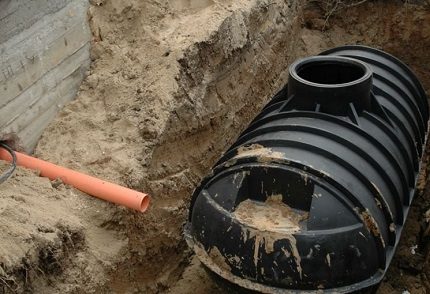
When selecting a suitable septic design, the frequency and cost of cleaning it must be calculated in advance. The volume of the sewage machine is 4-13 cubic meters. The type of equipment required directly determines the price of waste disposal
When developing a project, there may be some difficulties associated with hydrogeological features and terrain. The pipeline is laid under a slope so that the sewage flows by gravity. This can be difficult with a complex landscape. In such cases, either more carefully select a place for a septic tank, or put pumps for forced pumping sewage.
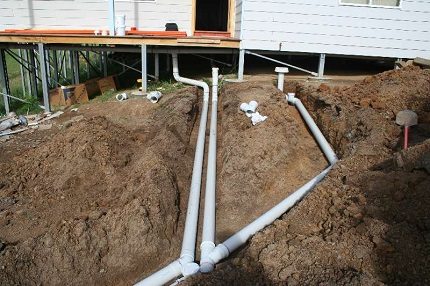
According to the norms, the pipes are laid below the freezing level of the ground. The depth of the pit can reach 1.5 m, and in some regions - 1.8 m
Depending on the type of soil, the post-treatment systems for septic tanks are designed. These can be filtration fields or filter cassettes. The first is expedient for use on sandy and sandy loam soils, and the latter - on clayey and loamy soils. The choice of the type, the material of the septic tank, the features of its installation is also influenced by the groundwater level.
Selection of materials for the arrangement of the system
Most homeowners choose sewer pipes made of synthetic materials. They are suitable for both internal and external wiring. This is a strong product, resistant to corrosion. With a strong mechanical action, they are able to deform, but rarely give a crack.
On the smooth inner walls of polypropylene and polyvinyl chloride pipes, deposits accumulate less than on metal surfaces. Due to this, the sewer network is less prone to blockages.
Products made of polymers are resistant to acids and alkalis. Chemically active wastewater does not cause damage to the pipes, which has a positive effect on the life of the pipes. Also polypropylene and polyvinyl chloride are well tolerated by high temperatures (up to 60-100 degrees).
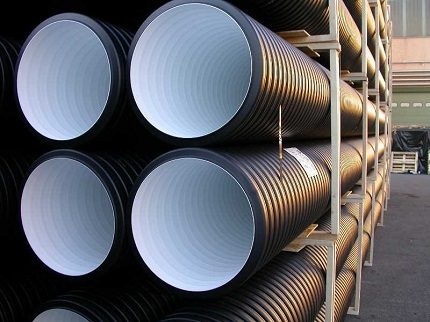
Pipes from polymers are environmentally safe. When heated, materials do not release toxic substances into the atmosphere, water or soil
For installation of the pipeline, it will be necessary to connect fittings, tees, fittings. To make it convenient to inspect and repair the sewage system, it is necessary to take care of the presence of revision niches, wells and manholes for them. It is also necessary to choose a suitable sealant for processing joints. It is best to give preference to a special silicone compound with antiseptic additives.
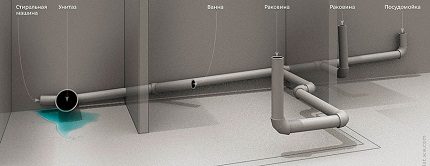
When planning the connection points of the sanitary equipment, you need to take care that the toilet is slightly lower than the other appliances, and next to the riser
For internal sewage network select pipes of different diameters, depending on the size of the nozzles of the plumbing equipment.
The riser pipe usually has a diameter of 100 mm. When planning its location take into account that the plumbing should be located at a distance of not more than 3 m. Stoic is usually mounted in the bathroom, tk. the distance to the toilet should not be more than 1 m. In the event that it is impossible to locate the elements of the system at such distances, larger diameter pipes should be installed.
Internal sewerage of a private house
When designing a sewerage project, you need to calculate the correct slope angle. It should be 2-15 cm per 1 m. The sections with 90 ° pipeline turns are thought through so that 2-3 knees are used, which are set at 30-45 degrees. This is necessary to avoid the accumulation of impurities in the knees and blockages.
Sewer pipes and risers often mask behind plasterboard boxes. To prevent the appearance of noise during the operation of the system, it is isolated with a mineral wool or other suitable materials.
Pipes of sewerage are connected to sanitary ware with the help of siphons with hydraulic locks. They prevent the flow of air from the sewer into the room. These devices can be metal or plastic. When choosing a better orientation on the material sewer pipes. If they are polymeric, it is advisable to install plastic siphons.
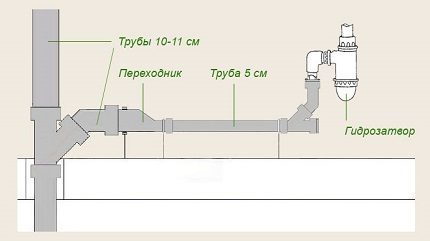
Some plumbing fixtures are initially equipped with siphons, and in the toilet bowls it is provided for in the design. If the sink or bath is sold without siphons, they are purchased separately
Siphons can be corrugated, have a bottle or pipe form. Devices of the first type are the cheapest. They are convenient in installation and operation, resistant to aggressive chemicals. However, they are undesirable to connect to sinks, in which hot liquids are often drained off.
Bottle siphons are similar in shape to a flask. This can be both an advantage and a disadvantage, since objects accumulate on the bottom of the device. If a ring or valuable object falls into the sink drain, it can be easily removed. On the other hand, because of this form in the siphon, clogs can form.
Tube siphons are U-shaped. At the lowest point of such a siphon, solid particles can also accumulate. They are removed using a special knee. In the hydraulic seal of the device a small amount of water, so it can evaporate and cease to protect from the smell of sewage.
There are also dry siphons. They dry up after the water is drained into the sewer. The devices are equipped with an elastic membrane, which prevents air from entering the room. Such a siphon will cost more than less technologically analogous, but with it there is no problem of evaporation of water from the water seal.
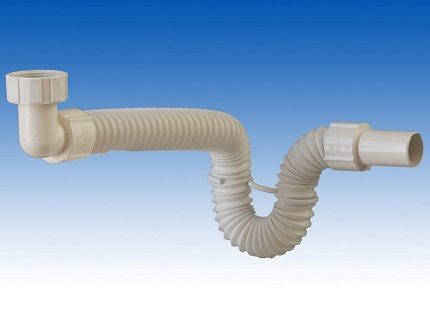
With all the advantages, corrugated siphons are sensitive to high temperatures, quickly deform and fail, so if possible, it is better to use other models
The upper part of the riser is taken out to the roof. It is not sealed, but well covered from rain and dirt. This is necessary, because At the time of water discharge in the system, a rarefied pressure is created, and air can be squeezed into the room. An alternative can be the installation of an aeration valve that lets air through, but protects the house from sewage stink.
Arrangement of external sewerage system
In the basement or under the floor the riser of the internal sewer is joined to the external pipeline. It is important to minimize the number of right angles and corners. The project of external sewerage is designed so that the septic tank is as close as possible, and the pipeline section is straight.
As for the pipe material, the choice in favor of polymers is rational. Installation of external sewerage of a country house is a laborious process, because is associated with large volumes of excavation. It is necessary to dig trenches to a depth below the freezing level of the soil. The bottom of the pit is rammed, a sand pillow is poured over which pipes are laid on a slope of 2-3%.
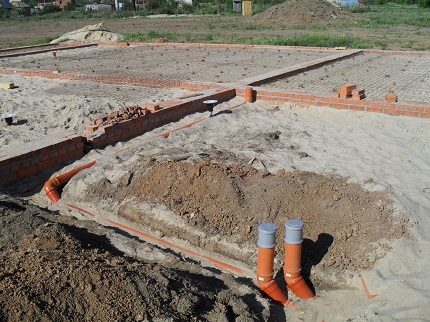
If severe frosts are possible, the pipes that are under the ground and in the unheated rooms of the house are insulated with heat-insulating material
Sewage from sewer pipes goes to storage or storage-treatment facilities. These can be cesspools or septic tanks. Homeowners are increasingly stopping their choice at autonomous biological treatment stations. Each of these facilities has its own merits, and should be chosen, focusing on the needs of the family, the amount of waste and the planned frequency of cleaning.
The cesspool is advisable to be built at the dacha or for sewerage of a country house, in which a minimum number of plumbing appliances is installed. Its only significant advantage is relative cheapness. Such a structure needs frequent pumping, and this is unnecessary costs in the process of operation.
When building a cesspool or a sealed storage cesspool it makes sense to mount check valveto prevent the flow of waste water from a flooded cleaning structure into the house. The valve also protects against rodents that can enter the room through pipes.
A good solution is to install a two- or three-chamber septic tank. In such a construction, sewage is defended, cleaned and filtered. The water at the outlet is relatively clean and safe for the environment. You can build a septic tank with your own hands or purchase a ready one.
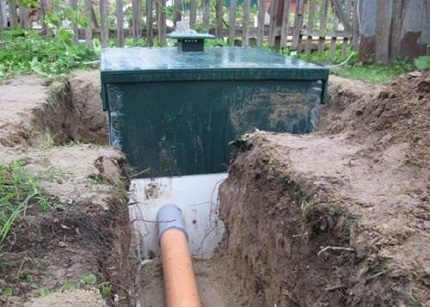
In most households, septic tanks are installed. Usually this plastic constructions, which must be additionally protected from ascent, freezing, punching of soils
The ideal option in terms of efficiency and environmental friendliness is a biological treatment station. This is a complex industrial equipment that purifies wastewater from harmful impurities by 95-98%. The stations have only one drawback - high cost, but if the owner of the site can afford such expenses, they will pay back a hundredfold.
Video for the construction of the sewer at home
Correctly selected scheme of canalization of a country house, accurate measurements and calculations, high-quality materials and competent installation are the guarantee of effective work of the future system. In some cases it is difficult to understand independently. We offer a useful selection of video materials on the arrangement of an autonomous sewer system of a private house.
A short lecture, which explains the principle of the system, the features of the choice of the scheme:
A visual demonstration, thanks to which it will be easier to understand the operation of the system:
When calculating the slope of external sewer pipes, mistakes are often made. Check out the video that will help you navigate through the design and installation of the pipeline:
Video materials on the device of ventilation of the sewer system:
The first and most responsible stage of construction is design. The more detailed and more precise the design of the sewerage system of the house, the easier it will be to use the ready system. If there are difficulties, do not hesitate to ask questions, ask for help from professionals. It is better to spend time and effort on clarifying the nuances than to subsequently face problems. Effective autonomous sewerage is not so difficult.
The construction of a country house is a laborious process. Therefore, it is necessary to take into account the main points and details in its formation. Sewer system for country houses and villas is an integral part. The construction of this sector is on the first place, in order to avoid negative consequences in the ecological sphere. There are many ways of laying sewer systems, connecting septic tanks and all kinds of sewerage units. Simplify the action can be, if the right approach to the selection of sewerage for buildings outside the city.
Components of drainage for buildings outside the city
Sewerage for a country house : what to choose? The answer to the question lies in the structural and constructive features this drainage system. Separate the main components of suburban drainage:
- Internal is a complex of connected pipes to all plumbing devices in the house.
- The septic tank is a reservoir for processing and collection of waste water.
- The outer element extends from the internal drainage to the sewage system.
- The organization of the waste complex is carried out with the help of of different types pipes: polymer, cast iron, asbestos-cement, and ceramic.
Pipes for external sewerageImportant: the use of cast iron or concrete pipes is not recommended. This is due to the awkwardness of the modifications.
Types of sewage
Each second suburban building is equipped with a sewage system, this design is missing only on small country plots. Conditions outside the city do not allow you to quickly and correctly connect the complex. The result - suitable option autonomous drainage of local orientation:
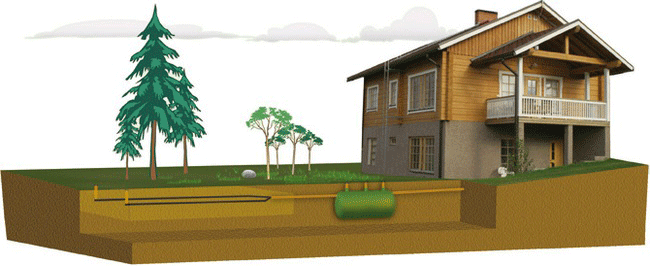
To determine the sewage system in a country house set of requirements:
- Analysis of soil cover on the territory.
- Calculation of the level of occurrence of groundwater.
- Identify the dimensions of the area for the disposal of the waste complex.
- Estimated volume of wastewater.
Local sewerage system
The components of drainage elements - septic tank, cesspool, and biological treatment station are present in different versions. How to choose a sewer for a country house, taking into account the characteristics internal parts drain system. A common problem is the classification of drainage elements on the basis of:
- The scheme of the device of the water drain. A variant is selected based on the type of waste components (food utilization, water treatment for a bathroom). The minimum for the price can be a bio-toilet, but the option is not very convenient, especially in the winter. The owner of the house outside the city will not be comfortable with this simplified sewer system. Other types of local drainage will cope with any type of waste.
- Structurality. This item is characterized by the definition of the functions performed by drainage (sewage accumulation, processing or purification). The simplest accumulator is a cesspool with a filtration bottom. Complex designs act as septic tanks, biological filters, purification stations. These modifications will save the site from the unpleasant odor and multiplication of bacteria.
- The development of a suburban area includes not only centralized and local sewerage. In cottages it is possible to install internal and external drainage. The internal drain is equipped with a pipeline (100 mm - diameter) and a slope to the outlet part, which includes taps for plumbing fixtures.
The ventilation modification is placed at the beginning of the drainage. External sewage system - a network section connecting the outlet part with cleaning structures. The organization takes place with the help of cast iron, asbestos cement and plastic pipes. A pipeline with a slope of 70 to 120 cm is placed to the side with the outlet of the pipe.
Important: the correct arrangement of sewerage indicates a simple operation. If clogs develop over time, they can be eliminated with a special cleaning cable.
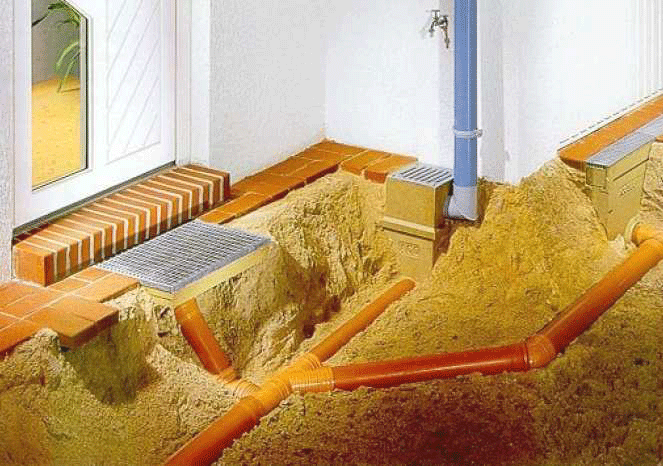 Element of external sewerage of a country house
Element of external sewerage of a country house Sewage pipeline installation
Begin the installation of pipes with the definition of height. The necessary bias (2%) is calculated. This is the standard measure for placing pipes in a drainage complex. If you take a bathroom, here the sink is located at the very bottom. In this case, the connection tee must be located at a certain level. It is possible to install a sewage system in the ceiling area of the basement. Provides the right slope and good sound insulation. Pipes should not be laid above the freezing level of the earth. Installation ventilation duct - the second step for normal operation of the sewage system. The stand prevents jumps in the drainage pressure, protects the water seals from evaporation. Provides aeration of the septic tank.
Important: laying pipes from the outside should go deeper than the freezing sector of the earth at 0, 5 m. If this is not possible, the pipes are insulated and installed together with the heating cable. This part is carried out at the bottom of the pipeline.
The construction of a cesspool
The design works on the principle of fluid accumulation from plumbing devices, and their subsequent treatment for bacteria. The bottom of the pit is covered with loose substances (pebbles, crushed stone, turf), which create the simplest stock complex. Types of sewage pit:
- The bottom is lined with turf or other loose material.
- The depth of the pit is covered by a sealed iron container.
- To isolate the cesspool drain, use a brick, plastic or metal container.
Important: overcrowded cesspool per 1 cubic meter provides a violation health requirements. The reason - harm to health around. In order to avoid a negative situation, you should call a special group to eliminate waste.
The model of the pit of the modern formation is represented in the form of a plastered groove where it is established ventilation tube. The standard dimensions of this sewerage detail: no more than 3х2 m, localization on the area of at least 5 m from the cottage and 2 meters from the neighbors. Availability cesspool on the site requires free space to enter the sewer machine.
Option - mechanical septic tank
The construction, consisting of chambers for sewage filtration, is called a septic tank. The liquid in this modification passes through several stages: sedimentation, clarification and processing by anaerobic substances. A solid sediment settles on the bottom of the first compartment of the septic tank. At the outlet, purified water enters the sewerage system. The modification has a number of advantages:
- The minimum price.
- Absence of dependence on electrical appliances.
- Practicality of the model.
- Protective function against the appearance of unpleasant odor.
The mechanical cleaning tank is represented by a finished product, which gives positive results in wastewater treatment. The septic tank is a more loyal solution after the cesspool.
 Mechanical septic tank with the filtering field
Mechanical septic tank with the filtering field Cleaning complex - universal execution
The application of biological treatment systems is popular in suburban areas. Formation includes a septic tank, which conducts the initial stage of water purification by anaerobic bacteria. The structure is equipped with a biological filter, which removes pollutants and sediments. This process is carried out by running water through the expanded clay, and biofilm. The reservoir (aerotank) purifies the liquid with sludge compounds. Acceleration of the action depends on the air supply to the bio-cleaning station. A more expensive version of the sewage system is equipped with finishing devices that remove impurities up to 99%. Main types:
- Finished factory modification.
- Modular complex, installed in accordance with the requests of the buyer. The structure can be made of a metal base, durable plastic and concrete.
The combination of additional elements of the bio-cleaning station regulates the sewage capacity. For a typical summer residence such a complex does not work, for a cottage or a country house is an excellent option.
When purchasing a biological treatment station, the following is taken into account:
- The presence of high reliability in the equipment.
- The period of operation of the station should be such as the service life of a country house.
- Mounting the plant must comply with the requirements of SNIP.
- Formation of the sewage system should include free access to the replacement or cleaning of parts.
- The installation of the station should not consume much energy.
- Availability of an acceptable cost for the buyer.
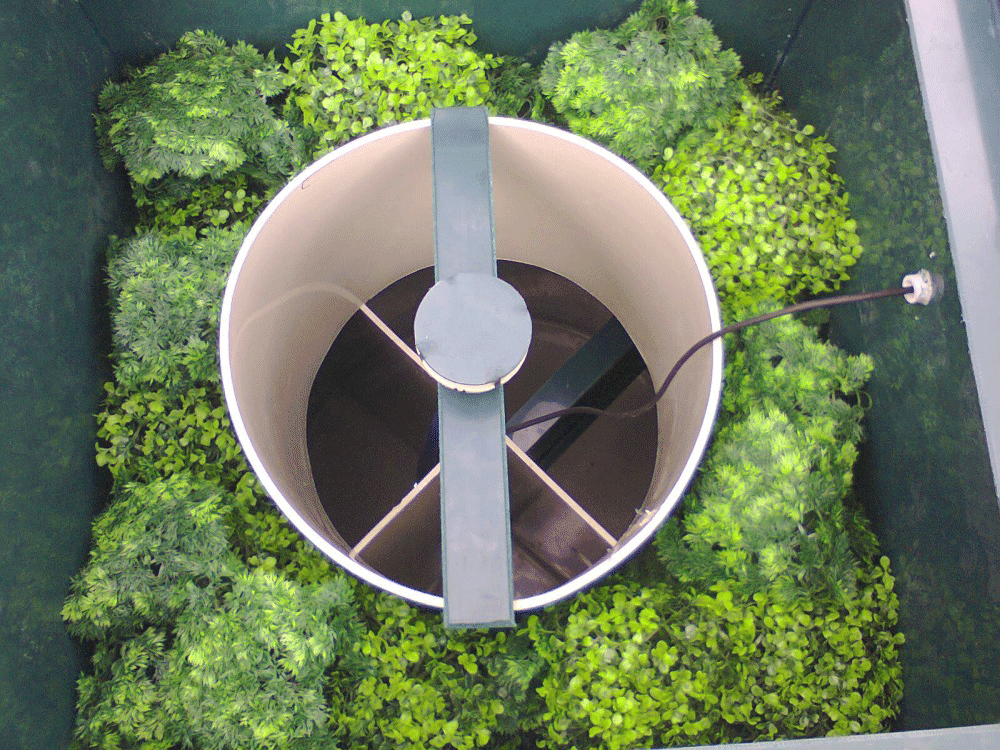 Installation of electrical septic tank
Installation of electrical septic tank Autonomous drain with aeration and stormwater
Modification with aeration is an innovative model among cleaning complexes. Due to the compactness of the texture, the station is easily mounted in a special foundation pit. Drainage is made of polymer material. The design is ergonomic, simple structure and affordable cost. Place the station so that the pipe connected to it does not have bends.
The owner can secure the foundation of the house thanks to the installation of a storm complex. Drainage performs the function of protecting against premature destruction. The main action of the drain is the assembly and drainage of water, which accumulates on the site. Mounting of the roof of the storm drain occurs at the first stages of building the roof of the house. On the finished surface installed trays that collect water and funnels, guiding it through the drain pipe.
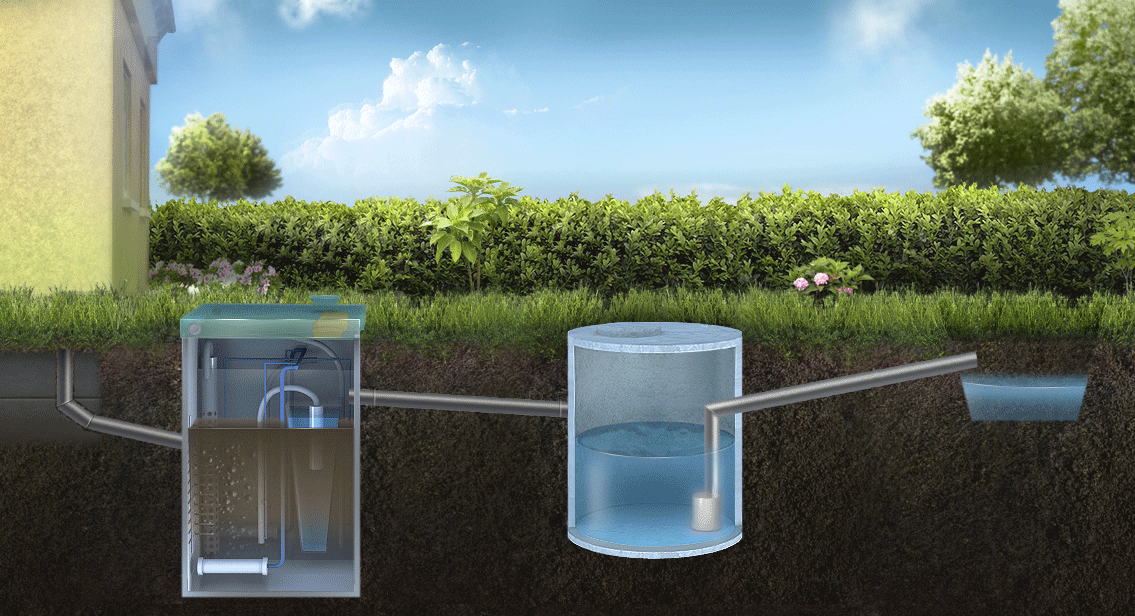 Scheme of sewerage with aeration and livnevkoi
Scheme of sewerage with aeration and livnevkoi
After choosing a sewer system, care should be taken for minor risks that may arise:
- Waste receipt balance. The pipeline should be simplified and rectilinear. This will ensure the easy flow of waste in the right direction. Situations when the pipe can not be made even in the bending and connecting sector are installed revision couplings and wells.
- Pipe connection. It is inadmissible to organize the fastenings and turns of the pipeline at an angle of 90 degrees. The flow direction should be smoothly distributed through the pipes. This process is carried out with consecutive mounting angles.
- Compliance with the diameter of the pipeline. Reduce the size of pipes in the direction of water movement is impossible. This contributes to the expansion of the pipe structure. The internal sector of the containers must not contain protruding parts.
- Installation of a return sewer valve. The device passes the waste only in one direction. In the event of a reverse load, the valve closes the drain, protecting the house from flooding with harmful substances.
- Mounting grease trap. The design includes two tanks with a special clearance. The interaction of these pots allows you to remove fat that gets into the sewer. Install the device in the kitchen sink.
Modern cottage in terms of comfort level, as a rule, not only not inferior, but also superior to city apartments. But in order for this statement to become true, when building a house, it is necessary to study as much as possible the sewage system in the country house with their own hands and the technology of its installation.
Today, many home masters refuse from the services of builders, preferring to make various repair and construction works in the house on their own.
The reasons for this desire may be different. Someone does not trust the quality of the work of hired workers, but someone is more important saving money, as construction services are currently quite expensive.
When you undertake the implementation of such a project as sewerage in a country house, you should take into account that the work is quite complex and requires not only practical building skills, but also serious theoretical training.
Therefore, it is worthwhile to get acquainted with the educational literature on this issue.
The first stage of any construction is the drafting of the project.
And the device of the canalization of a country house is no exception. It should be noted that the complexity of this part of the project largely depends on the layout of the house.
So, the simplest case is considered the option, when all points requiring water disposal (kitchens, bathrooms, laundries, etc.) are located compactly.
In this case, the drains can be combined into a common collector with drainage to the single.
But how can a sewer be made to a layman in the house?
For example, if the house plans to install several bathrooms located in different parts of the house, as well as the construction of a sauna and a swimming pool.
In this case, the project will require serious and professional work, so it must be performed by specialists with relevant experience.
Designing a complex system without the help of professional designers is incredibly difficult, and error correction, as a rule, is much more expensive than the project itself would cost.
Material selection
As a rule, the sewerage in the country house is made of plastic.
Few home craftsmen will work with cast-iron or asbestos-cement pipes. The use of such materials greatly complicates the installation, and the quality of the plastic systems is no worse than that of cast iron.
Number and diameter of pipes, as well as required amount fittings is determined according to the design.
When choosing a material, it should be borne in mind that there are pipes that are designed for laying only in rooms, and there are specially designed for outdoor installation.
For internal wiring, as a rule, polypropylene pipes, having a diameter of 50 mm. Only for the riser and for draining the drains from the toilet take a pipe with a large (100 mm) diameter.
Polypropylene pipes are attractive because they are easy to make, they do not require a special tool and special skills for their connection.
In addition, they are durable, durable and can be applied, both for external laying on walls, and for flush mounting under the floor or in a wall.
As a rule, the sewerage project in a private house provides for the installation of local treatment facilities.
It can be a septic tank or a more modern cleaning plant.
The choice of treatment plant is carried out taking into account:
- The relief of the site;
- Characteristics of the soil;
- The volume of expected wastewater;
- Opportunities of the hosts.
It should be noted that the purchase of ready-made units (septic tanks, treatment facilities, storage tanks) is more expensive than the installation of these structures by the traditional method using concrete rings or brickwork.
But this acquisition greatly facilitates the installation and allows us to do without the use of lifting equipment. Therefore, you should evaluate all aspects before choosing the most profitable option.
In addition to accounting for installation costs, you should also evaluate the operating costs that the installation will require in the process.
How often will I need to clean? Is it necessary and in what quantities to buy a reagent or a biomaterial for a septic tank? Is it difficult to maintain this system?
Only after analyzing the answers to these questions, one can find the most acceptable option and make the sewerage in a private house at a lower cost.
Stages of construction
Thus, if it is planned to build or restore a private house - The sewer must be planned first. After all, without effective work of this system it is impossible to provide a decent level of comfort. »Width =» 640 "allowfullscreen =" »frameborder =" 0 "\u003e
Stages of construction
If you break the construction of the sewage system into stages, you will get the following list:
- Digging a pit for the installation of a septic tank or storage tank;
- Trenching for an external pipeline;
- Installation internal system pipelines;
- Installation and warming (if necessary) of the external pipeline;
- Installation or construction of a septic tank;
- Connection of all elements of the system.
Typically, the sewerage in the private house begins when the walls and interior partitions are already completely ready, and a roof is also built.
In most cases, make in the thickness of the rough floor, so in the cement fill it will be necessary to make trenches for their laying with the help of a Bulgarian.
These trenches lead to a hole in the foundation, which was specially left for the discharge of the sewer pipe.
Then begin the installation, starting from the lowest point, and make sure that the pipe sockets are directed in the direction opposite to the flow of the drains.
Rubber gaskets are used to seal the joints. It is extremely important to ensure that the pipes run under the projected bias, otherwise, there will be problems with the transportation of waste water.
Sewerage (in construction) in the middle lane is organized, as a rule, at a depth of about 0.5 meters. Do not be afraid that in winter the soil freezes to a great depth.
The fact is that in a properly planned pipeline, the drains are not delayed, but immediately transported to the destination.
In addition, as a rule, the sewage runoff temperature is at least roomy or even higher, so this freeze-out location of the system does not threaten.
Advice! Too far to place the release is not recommended, since then it will be difficult to provide the necessary slope of the external pipeline, and the septic tank will have to be placed too deep.
The most difficult cases in the construction of local sewage systems are those that recognize the high location of groundwater and / or clay soil on the site.
In the first case, it is impossible to build a traditional cesspool and a septic tank, as they will be filled with water coming from the ground.
In the presence of clay soil, difficulties arise with the installation of filtration wells or filtration fields.
In the presence of such complex devices, it is worthwhile to acquire ready-made sewage treatment plants having hermetic, ribbed rigidity and therefore able to withstand heavy loads of the housing from durable plastic.
Thus, if it is planned to build or restore a private house - the sewage should be planned first. After all, without effective work of this system it is impossible to provide a decent level of comfort of living.



